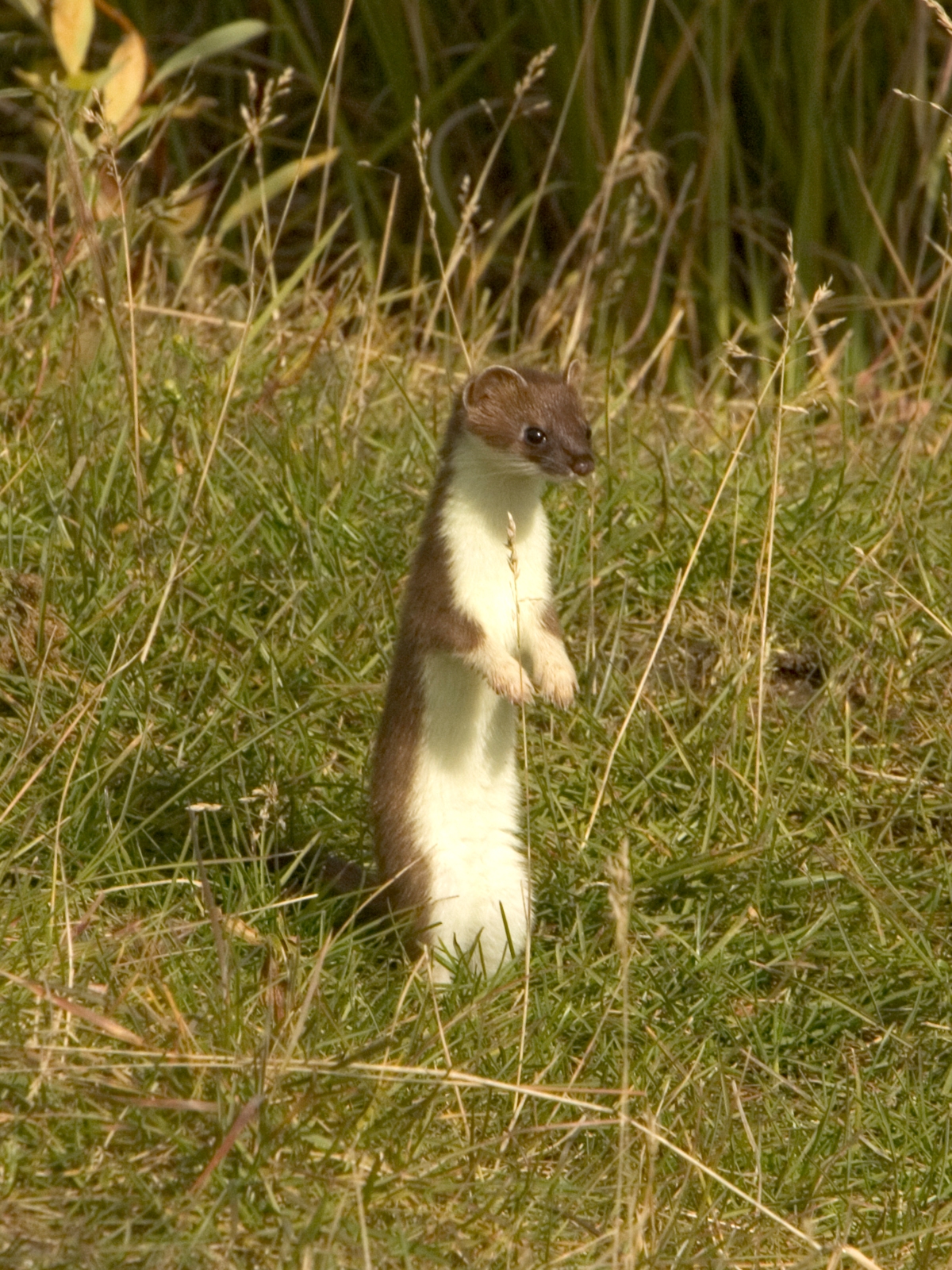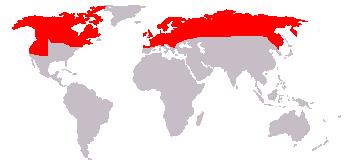- Ermine
Taxobox
name = Ermine (or Stoat)
status = LR/lc | status_system = IUCN2.3

regnum =Animal ia
phylum = Chordata
classis =Mammal ia
ordo =Carnivora
familia =Mustelidae
subfamilia =Mustelinae
genus = "Mustela "
species = "M. erminea"
binomial = "Mustela erminea"
range_
range_map_caption=Range map
binomial_authority = Linnaeus,1758 The Ermine ("Mustela erminea") is a small
mammal of the familyMustelidae . It is also known as the stoat and the short-tailed weasel.Natural history
The Ermine can be found almost everywhere throughout the northern temperate, subarctic and Arctic regions, of
Europe ,Asia , andNorth America . In an unsuccessful attempt to control therabbit population, it was introduced intoNew Zealand . Ermine are largelynocturnal orcrepuscular but will sometimes come out during the day.Physical description
The Ermine is a member of the family
Mustelidae , which also includes other weasels,mink ,otter s,ferret , badgers,polecat s, thewolverine ,marten s, thetayra , the fisher and in some taxonomical classificationsskunk s. This is one of the most species-rich families in order Carnivora. The Ermine moves in a sinuous manner when pursuing its prey extremely quick over the ground considering its small size, and is also a strong swimmer that is able to colonize offshore islands. Although it inhabits northern latitudes, the Ermine is built long and thin, leading to an increased surface area-to-volume ratio and increased dissipation ofheat from its body. The advantage of this shape is that it is one of the few species able to follow burrowing animals into their own homes. It partly compensates for this shape by having short legs, smallear s, a fastmetabolism and, in winter, thickfur . Ermines may grow up to 30 cm long, with males much larger than the females. In most areas it coexists with the weasel ("Mustela nivalis", also known as theLeast Weasel ), the smallest member of order Carnivora. Where the weasel is absent the Ermine is smaller (~70 g).The Ermine's coat is a rich medium brown with an off-white belly. In
winter , the coat is thicker and in regions that experience an inch or more of snow for at least forty days of the year (such as inArmenia [Christopher J. Walker, "Armenia: Survival of a Nation," London, 1990] ), the color changes to clean white. This white fur is known as "ermine", a term originating either from the Latin phrase "Armenius mūs" ("Armenian rat") [ [http://dictionary.reference.com/browse/ermine ermine - Definitions from Dictionary.com ] ] or from a word common to the Germanic and Baltic languages, [ [http://starling.rinet.ru/cgi-bin/etymology.cgi?single=1&basename=/data/ie/piet&text_number=+++543&root=config Indo-European etymology : List with all references ] ] hence the scientific name. At this stage, where the animal is known as a "stoat", it may be referred to as ermine, or as being "in ermine". The winter Ermine has been used in art as a symbol of purity or virginity. The white fur was highly prized, and used in the robes of theLord Chief Justice of England . Both the animal and the heraldic tincture are symbols ofBrittany . The furs would be sewn together making a pattern of black dots. A version of this pattern is used in heraldry as ermine tincture.In all seasons the Ermine has a black tip to its tail. The black tip probably serves as a decoy to predators, which would include almost any carnivore large enough to eat a Ermine (e.g. wolves, foxes, wolverines, and some birds of prey). This kind of coat is very similar to the coat of the
long-tailed weasel ("Mustela frenata"), a related animal of about the same size which also moults into white in the northern part of its range, and it is easy to confuse these kinds of weasels. The North American name for the Ermine, the "Short-tailed weasel" arose because its tail length distinguishes it from the long-tailed weasel. In general it is found farther north. Both species can be distinguished from the weasel because the weasel lacks a black tip on its tail.Geographical range
The Ermine is native to the area between the 40th parallel (north) and the beginning of the
Arctic Circle , which encompasses most of northernEurasia andNorth America .They have been introduced to
New Zealand andAustralia to control arabbit overpopulation but found an alternative source of food easier to catch thus leaving the rabbit problem unsolved. They were also brought to Terschelling Island to control water voles ("Arvicola terrestris"). Ermines can swim up to 1.5 kilometers across seawater and have already reached several New Zealand offshore islands unaided.Maud Island which is 900 meters offshore has been colonised multiple times in the past 20 years.Diet
The Ermine is a carnivore. It eats
insects ,rabbit s;rodent s such as themouse ,vole andrat ; other small mammals;bird s and their eggs and young; and sometimesfish ,reptile s,amphibia ns, andinvertebrate s. It is a very skillfultree climber and can descend a trunk headfirst, like asquirrel . The Ermine is capable of killing animals much larger than itself. When it is able to obtain moremeat than it can eat it will engage in "surplus killing" and often stores the extrafood for later. When this is the case, it will often kill by breaking the prey's neck without marking the body, presumably so its cache does not spoil easily.There are several recorded instances of Ermines 'transfixing' rabbits by exhibiting a tumbling routine akin to a dance. Rabbits appear hypnotised by this activity and fail to notice the Ermine approach within striking distance. Once close enough, the rabbit falls easy prey to the Ermine.
Like other
mustelid s it typically dispatches its prey by biting into the base of theskull to get at the centers of thebrain responsible for such important biological functions asbreathing . Sometimes it will also make preliminary bites to other areas of the body. In most areas in which Ermines and least weasels co-exist, the weasel generally takes smaller prey and the Ermine slightly larger prey. The larger male Ermines generally take larger prey than females. Commonly, the Ermine falls prey to animals such as the wolf, fox, cat or badger.Reproduction
The Ermine is territorial and intolerant of others in its range, especially others of the same sex. Within its range, it typically uses several dens, often taken from
prey species. It usually travels alone, except when it is mating or is a mother with older offspring. It breeds once a year, producing several young kits (or kittens) per litter, and its mating system is promiscuous. Copulation occurs during the mating season with multiple partners and is often forced by the male, who does not help raise the offspring. Sometimes it occurs when the female is so young she has not even left the den. In spite of being such a small animal, the Ermine'sgestation is among the longest reported for mammals (11month s) because of the adaptation of delayed implantation, or embryonic diapause, in which a fertilized egg is not implanted in theuterus until months later. The animal's "real" gestation is much shorter. This is presumably an adaptation to the highly seasonal environment in which the Ermine lives.enses and behavior
Communication (and also location of prey) occurs largely by
scent , since the Ermine as typical of mammals has a sensitiveolfactory system . As a result much of this communication is missed by human observers. However, Ermines are believed to identify females inestrus by scent, and also the sex, health and age of prey. Some kinds of rodents such as voles have counter-adapted by being able to shut down reproduction (which makes females slower and easier to catch) if they smell the odor ofmustelids . The Ermine's visual resolution is lower than that of humans andcolor vision is poor, although night vision is superior. Like most other non-primate mammals they havedichromat ic colour vision (they can distinguish long from short wavelengths of light, but cannot make distinctions of hue within those bands). Tactile information is conferred by thevibrissae , or whiskers. When alarmed, a Ermine can release a powerful musky smell from glands near its anus.ubspecies
* "Mustela erminea"
** Yellow-necked ermine "Mustela erminea ?" Range: NorthernShaanxi ,China
** "Mustela erminea alascensis"
** "Mustela erminea algiricus"
** "Mustela erminea anguinae"
** "Mustela erminea angustidens"
** "Mustela erminea Arctica"
** "Mustela erminea audax"
** "Mustela erminea bangsi"
** "Mustela erminea celenda"
** "Mustela erminea fallenda"
** "Mustela erminea ferghanae"
** "Mustela erminea gulosa"
** Ermine haidarum "Mustela erminea haidarum" Range:Queen Charlotte Islands , Canada
** "Mustela erminea herminea"
** "Mustela erminea hibernica" (Thomas and Barrett-Hamilton) Range:Ireland ,Isle of Man
** "Mustela erminea imperii"
** "Mustela erminea initis"
** "Mustela erminea invicta"
** "Mustela erminea kadiacensis"
** "Mustela erminea kanei"
** "Mustela erminea labiata"
** "Mustela erminea leptus"
** "Mustela erminea lymani"
** "Mustela erminea microtis"
** "Mustela erminea mortigena"
** Ermine weasel "Mustela erminea muricus"
** Hondo stoat "Mustela erminea nippon" Range: Central and northernHonshū , [http://japan-animals.blogspot.com/ Hondo Stoat]Japan
** Olympic ermine "Mustela erminea olympica" Range:Olympic Peninsula , Washington
** Ezo Stoat "Mustela erminea orientalis" Range:Hokkaidō , Japan; Japanese: "ezo-itachi" "Ezoweasel ", "okojo" "stoat/weasel", "shiro-ten" "white marten"
** "Mustela erminea polaris"
** "Mustela erminea pusilla"
** "Mustela erminea richardsonii"
** "Mustela erminea rixosa"
** "Mustela erminea salva"
** "Mustela erminea seclusa"
** "Mustela erminea semplei"
** "Mustela erminea streatori"
** "Mustela erminea vulgaris"
** "Mustela erminea whiteheadi"Ermines and the nobility
The skins of Ermines were prized by the fur trade, especially in winter coat, and used to trim coats and stoles. The fur from the winter coat is referred to as "ermine". In Europe these furs were a symbol of royalty; the ceremonial robes of members of the UK
House of Lords are trimmed with ermine, though artificial fur is now used. The ermine was also considered a symbol of purity in Europe. In theRenaissance era, legend had it that an ermine would die before allowing its pure white coat to be besmirched. When it was being chased by hunters, it would supposedly turn around and give itself up to the hunters rather than risk soiling itself.Henry Peacham 's "Emblem 75", which depicts an ermine being pursued by a hunter and two hounds, is entitled "Cui candor morte redemptus" or "Purity bought with his own death." Peacham goes on to preach that men and women should follow the example of the ermine and keep their minds and consciences as pure as the legendary ermine keeps its fur. [ [http://f01.middlebury.edu/FS010A/STUDENTS/n075.htm The Minerva Britanna Project] ] In some Nordic countries the Ermine is invoked as a symbol of curiosity and timely action. In some areas ofJapan , because of its adorable appearance and somewhat elusive nature it is still considered a symbol of good luck.Gallery
Footnotes
References
* King, Carolyn. "The Natural History of Weasels and Stoats". London: A & C Black, 1987. ISBN 0747018006.
*
* Buckley, D.J., Sleeman, D.P. and Murphy, J. 2007. Feral ferrets "Mustela putorius furo" L. in Ireland. "Ir. Nat. L." 28:356–360.
* Molinia F.; La Falci S.; Myers V.; McLane D. (2007) Non-invasive monitoring of stoat reproductive hormones. "Science for Conservation 276". p 24. Department of Conservation, New Zealand. [http://www.doc.govt.nz/upload/documents/science-and-technical/sfc276.pdf]
* O'Connor C.; Turner J.; Scobie S.; Duckworth J.D. (2006) Stoat reproductive biology. "Science for Conservation 268". p 24. [http://www.doc.govt.nz/upload/documents/science-and-technical/sfc268.pdf ]External links
* [http://www.arkive.org/species/ARK/mammals/Mustela_erminea/ ARKive]
* [http://www.funet.fi/pub/sci/bio/life/mammalia/carnivora/mustelidae/mustela/index.html#erminea "Mustela erminea" taxonomy]
* [http://www.doc.govt.nz/templates/podcover.aspx?id=33448 Ermine control information]
Wikimedia Foundation. 2010.
